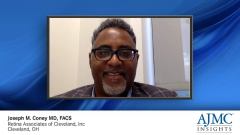
Addressing Differences in Social Determinants of Health Among Patients With Diabetes: The Role of Community Engagement
Joseph M. Coney, MD, FACS, emphasizes the vital role of community engagement in tackling difference in social determinants of health among patients with diabetes and highlights the significance of multilevel efforts to enhance community health outcomes.
Episodes in this series

Joseph M. Coney, MD, FACS: Community engagement is a very pivotal point for all of us when it comes to conquering or addressing social determinants of health. The education piece, whether it’s dealing with food scarcity, whether it has to do with health literacy—these are all important columns, which limit our ability to provide adequate health care. The health literacy piece is really important. We know that individuals who have a less than a high school education, we know from multiple studies that they not just only have a problem with diabetic edema, but they also present with worse visual acuity. We know that it’s also tied to socioeconomic status, and this also ties into health literacy. Being present in the community to be a platform to educate people about how different diseases affect their body I think is important, particularly when it comes to diabetes. The reason why it’s critical is because diabetes, unlike a lot of other problems… is something that’s treatable. In my opinion, there’s no reason why anyone needs to go blind from diabetes and unfortunately, [it] is still the No. 1 cause of blindness in the working age population and is much more common in underserved communities. I think that education is really critical. Reaching out to patient advocacy groups, reaching out to churches and other organizations, which have a large group of individuals that they trust, I think is important. That trust factor is critical.
We don’t realize the importance of having our pastors and our priests in our communities. [Patients] oftentimes will listen to them more than the doctor themselves. If you’re able to partner with these individuals, that’s already 1 link of communication, which I think is really important. But the education piece is critical. If you can get involved in the community in any kind of way, in different societies that may be present, I think that’s also very helpful. The more interconnections you have is critical. It’s also important as a clinician to have hours that may be available for individuals that may have a hard time coming to the office. We offer Saturday office hours for those individuals. Everyone can’t take off work to come [during the week]. I think [how we’ve] branded ourselves in the community [is] as always being available and also being accessible. We have early morning hours starting at 7:30 AM and hours going down to 5 PM. We have a broad stroke in order to address these individuals.
We also put clinics where patients are, if you want to make [a] bigger [impact]. The biggest impact you need to be where the community is. You have to go to the community. Oftentimes we have offices that are in these big institutions, and we never leave the walls of the institutions. Well, the problems are not in those walls, but [they are] in the community. Putting an office in that community is really important. Having a satellite [office] there. Having someone who can be an advocate for the patient, whether it’s a physician extender, whether it’s a PA [physician’s assistant], a nurse who can answer questions, or someone who can get follow-ups about how their exam was, that they follow with a primary care doctor, I think is all important.
The primary care piece is critical. Some studies have shown that individuals who do not have a primary care physician don’t have an ophthalmologist. Making the communication, doing the follow-ups with the primary care doctor, with the endocrinologist, will also help with the adherence of therapy and also help with individuals coming in to be evaluated for their diabetes. The community piece is important and the more interactions you have on different levels, I think are critical.
This transcript is AI generated and reviewed by an AJMC® editor.
Newsletter
Stay ahead of policy, cost, and value—subscribe to AJMC for expert insights at the intersection of clinical care and health economics.






























































